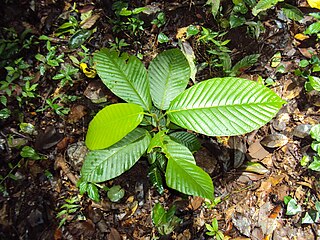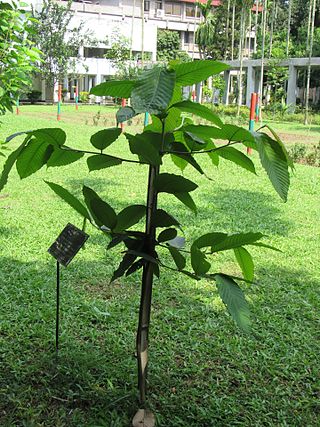
Dipterocarpus retusus, commonly known as hollong, is a large tree and perhaps the best known species in the genus Dipterocarpus. It is native to China, Vietnam, Philippines, Laos, Cambodia, Malaysia, Indonesia, Myanmar, and India. The tree, some 20–30 metres (70–100 ft) tall, is found in Cambodia in dense forests of the plains, common on hillsides and along rivers and in forests between 800 m (2,600 ft) and 1,500 m (5,000 ft) altitude.

Dipterocarpus is a genus of flowering plants and the type genus of family Dipterocarpaceae.
Dipterocarpus coriaceus is a species of tree in the family Dipterocarpaceae endemic to Kalimantan, Sumatra and peninsular Malaysia. This very large tree occurs in mixed dipterocarp forests on hillsides and undulating land. This species was reported in the New Straits Times to be extinct in Peninsular Malaysia in July 2013 as its last natural habitat in Bikam Forest Reserve in Perak was de-gazetted and cleared for oil palm cultivation.

Dipterocarpus gracilis is a critically endangered species of tree in the family Dipterocarpaceae, native to South Asia and Southeast Asia.
Dipterocarpus hasseltii is a species of tree in the family Dipterocarpaceae. This large tree occurs in lowland dipterocarp forest and is cut for keruing timber. It is found in Indonesia, Peninsular Malaysia, Sabah, the Philippines, Thailand and Vietnam.
Dipterocarpus humeratus is a species of tree in the family Dipterocarpaceae. The species name humeratus is derived from Latin and refers to the articulated petiole. D. humeratus is an emergent tree, up to 50 m tall, found in mixed dipterocarp forests on well-drained clay soils. The species is found scattered or semi-gregarious on undulating land and clay ridges below 700 m elevation. It is found in Sumatra and Borneo and occurs in at least three protected areas.
Dipterocarpus kerrii is a species of tree in the family Dipterocarpaceae, native to the Andaman Islands, Sumatra, Borneo, Peninsular Malaysia, Laos, Myanmar, the Philippines, Singapore, Thailand and Vietnam.

Dipterocarpus grandiflorus is a species of flowering plant in the Dipterocarpaceae family. It is an endangered medium hardwood tree of Southeast Asia. It is a large tree which can grow up to 50 metres tall.

Dipterocarpus condorensis is a species of plant in the evergreen or semi-evergreen family Dipterocarpaceae.
Dipterocarpus confertus is a species of plant in the family Dipterocarpaceae. The species is named derived from Latin and probably refers to the indumentum. It is an emergent tree, up to 50 m (160 ft) tall. It is widespread in mixed dipterocarp forest on leached yellow clay soils up to 800 meters elevation. It is endemic to Borneo. The species is threatened by deforestation. It is a medium hardwood sold under the trade names of Keruing. It is found in at least one protected area.
Dipterocarpus conformis is a species of plant in the family Dipterocarpaceae. The species is named derived from Latin and alludes to the great similarity in vegetative characters with two other large-leaved Dipterocarpus species. There are two subspecies; D. conformis subsp. conformis which is confined to Aceh and North Sumatra and D. conformis subsp. borneensis which is confined to Borneo. D. conformis subsp. borneensis is an emergent tree, up to 50 m tall, in mixed dipterocarp forest on clay soils over shale. It is a medium hardwood sold under the trade names of Keruing.
Dipterocarpus crinitus is a species of plant in the family Dipterocarpaceae. The species name is derived from Latin and refers to golden-brown bristle-like hairs that cover the plant parts. It is an emergent tree, up to 60 m tall, in mixed dipterocarp forest on sandy clay soils. It is a medium hardwood sold under the trade names of Keruing. It is found in Peninsular Thailand, Sumatra, Peninsular Malaysia and Borneo.

Dipterocarpus alatus, also known colloquially as the resin tree, is a tropical forest tree, of dense evergreen or mixed dense forests, in tropical Asia. It is considered vulnerable.
Dipterocarpus dyeri (Khmer: rôyiëng, chhë tiël pruhs, chhë tiël th'nô:r, local name Kompong Thom: chhieutiel chgor, name used for commercial timber and the group of trees harvested for such: keruing, Vietnamese: Dầu Song Nàng, is a species of tree in the family Dipterocarpaceae found in Myanmar, Thailand, Peninsular Malaysia, Cambodia, Vietnam, and northwestern Borneo. The tree is found in rain forest and lowland semi-evergreen dipterocarp forests, an alternative habitat description is mixed dense forests of the plains, mainly among rivers and valleys. The tree is a climax or late successional species, which in some secondary forests forms relatively young pure colonies. The conservation status is based on rates of habitat loss, the major threat to the taxa, though in Vietnam it is cited as having a less threatened conservation status of Vulnerable.

Dipterocarpus intricatus is a species of tree in the family Dipterocarpaceae found in Thailand, Cambodia, Laos and Vietnam.

Dipterocarpus turbinatus is a species of tree in the family Dipterocarpaceae native to north-eastern India and mainland Southeast Asia, and cultivated in surrounding regions. It is an important source of the wood known as keruing, and is often used in the plywood industry.
Dipterocarpus lowii is a tree in the family Dipterocarpaceae.
Dipterocarpus nudus is a tree in the family Dipterocarpaceae.
Dipterocarpus pachyphyllus is a tree in the family Dipterocarpaceae. The specific epithet pachyphyllus means "thick leaves".
Dipterocarpus stellatus is a tree in the family Dipterocarpaceae. The specific epithet stellatus means "star-like", referring to its trichomes.








